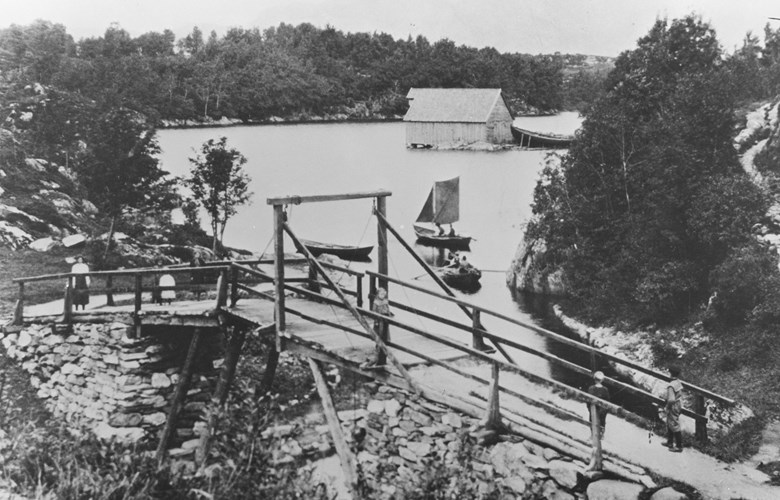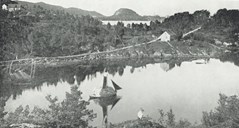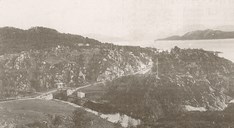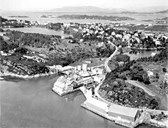An ideal harbour
Gaddevågen was an ideal harbour for the boat traffic at that time. Well sheltered against all winds, a centre for some handicraft and trade grew up along the long and sheltered bay. Three tradesmen were established in the area.
At Eidet there was also a small quay where the vicar could easily board his boat that was otherwise placed in his boathouse at Båtevika. When the steamship company called Nordre Bergenhus Amts Dampskibe (the present company of Fylkesbaatane) started its services in 1858, they made a stop at Eidet. The footpath from Brandsøya to Gunnhildvågen/Furesund was strategically located near by, with a path diverting to the vicarage and the main farm.
Demand for a canal
As the new city centre developed, and the trading activities increased there, a demand arose to build a canal through the narrow strip of land called Eidet between Gaddevågen and the Solheimsfjord.
A short while after Florø became a municipality in its own rights in 1860, a special harbour commission was appointed to bring up the canal issue. On 5 October 1867, the city council ordered the magistrate and the board of aldermen to apply to the county council and the neighbouring municipalities to ask for financial support for the project. On 1 October 1869, the city council allocated 300 speciedaler to the work, and it also assumed partial responsibility for the maintenance.
In 1871, a new request was sent to the county council, where they underlined the value and significance of the canal for the city and the district, as it was a long and frequently weather-exposed voyage west of the point of Havreneset to transport goods and passengers.
Førde supplied money
Florø was unable to cover more expenses for the construction project, but the city was willing to take care of all maintenance. Upon the county governor's recommendation, the city council, nevertheless, decided to allocate another 300 speciedaler. The municipality had then been promised an interest-free loan for ten years from Kinns Sparebank. The construction work was started in 1872. The neighbouring municipalities had interests in the project as well, which was shown when the Førde municipality supported the project with 200 kroner.
In 1873, the city council took over the responsibility for the completed canal. The total cost was 12 000 kroner. Florø had allocated 2400 kroner, the county 1200 kroner, the Kinn municipality 600 kroner, and Førde 200 kroner. The rest was covered by state means. When the canal was completed in 1873, people rowed through the canal and out into the bay of Gaddevågen, and further on to the new centre. The vicar's quay was moved into the more sheltered Gaddevågen, where the leisure-boat quays are located today.
Bridge across the canal
The city council also decided to build a bridge across the canal. The bridge was constructed in such a way that the middle section could be hoisted so that bigger boats could pass through without taking down their rigging. When the bridge was upgraded in the 1920s, it was made permanent so that the first car in the town could cross it. The bridge was built of solid wooden material and it stood for nearly 60 years until about 1930. Then a new bridge was built to be used by cars on the Brandsøyvegen road that was under construction.





